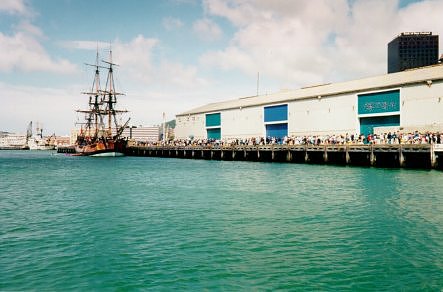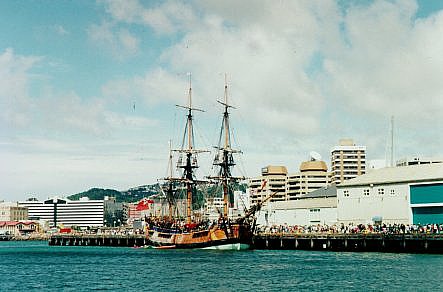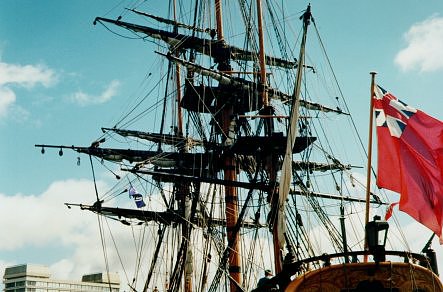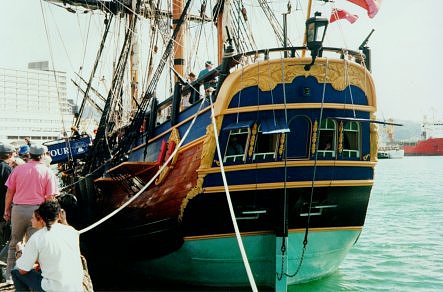
On February 2nd 1996, around mid-day, the full scale replica of the sailing ship 'Endeavour' came into Wellington Harbour.
With full sail up, as she came in through the heads, she cut an imposing figure on the water. Unfortunately I wasn't able to be near the heads when she arrived, and so didn't capture this scene on film. But the news camera crews did and the front pages of the Wellington newspapers all sported pictures of her.
On that Friday some 2000 plus people either escaped work or put off other tasks to come down to the wharf to welcome the ship in. Once she was up against the wharf the real size of the boat became more apparent. The photograph below gives you an idea of the scale of the boat.

Also visible is the queue that had formed to actually step on board the ship. Even with the somewhat exorbitant pricing the queues were long, some people waiting close to three hours from entering the queue till actually stepping onto the ship. On the day the photographs were taken the queue stretched along the wharf from the ship to the end of the wharf, around the whare-house and back again to start at about the same place the queue ended - near the ship.
A rough estimate would be that there was close to five hundred people in the queue at any one time while the ship was open for viewing. People who paid the money and waited the duration got to go below decks and stand on the ship proper.
Much as I might have liked to do that, not to mention I was dying to climb the rigging, the long queue put me off. Crowds make me grumpy and nervous, something in extended periods is not good for both myself and those near me.
Instead we ended up taking the Eastbourne Ferry that allowed me to take these shots from the harbour.

The above shot being taken as the ferry began to make speed out into the harbour. The below shot was as we rounded the end of the wharf after departing the Ferry mooring.

Arrayed on the wharf, next to the ship, was a series of stand-alone panels that had pictures and details about the ship and it's crew on the original Endeavour. Most notably was information on Captain Cook's famous voyage of discovery, or really re-discovery, through the Pacific with the botanist Joseph Banks.
I must admit to being more than a little curious about Joseph, for obvious reasons. I was surprised to learn that he apparently was interested in Astronomy as well as Botany and that he took a whippet with him on the journey. Two parallels that are fairly close to home. If I wasn't so sceptical I'd suspect some form of genetic/cosmic inheritance at work here.
Even more it brings closer to home the enormity of the task that the voyage was. Travelling so far in such a small and complex ship is no mean feat. To give you an idea of the complexity of the ship this next shot is of the rigging.

Even the master cabin was small and I must admit to feeling sorry for the whippet that came on the journey. I know our dogs like open space and plenty of room to move - so life aboard a cramped ship like the 'Endeavour', along with the frequent changes in weather, must have made life unpleasant at times for it.

I find myself now wishing that there was some record of how the whippet found life. Did Joseph record such details in any diary he kept? Did the dog make it back to England with him, or did it suffer mishap along the way? And what was it's breeding, by whom is it survived today?
Such details are not considered important enough for public merit and weren't mentioned on the boards. This is probably fair, after all it is only because I live with whippets that I am interested in such things.
The replica was built by an Australian consortium, to the tune of $80 million NZ dollars. Commissioned by the Australian Maritime Museum it was used as part of the bi-centennial celebrations in Australia. From what I remember of those celebrations, as reported on the TV, she cut an impressive figure then too - leading a flotilla of boats out of the harbour.
Staying only about a week she slipped away again, taking a touch of class with her. It was nice to see her in Wellington harbour, nice to know that through her a piece of history and the, almost, art-form of building such ships has survived to the present day.
Maybe next time I will get my chance to climb the rigging...
Lifted from the 'Encyclopedia of New Zealand' volume three, page 247, 1966 Edition.
"...is the Endeavour, the vessel used by Captain Cook on his first voyage to New Zealand. When the voyage was projected two naval sloops were considered and rejected. The Admiralty then suggested that a cat-built vessel of about 350 tons, with sufficient room for such a voyage, could be had in the Thames. Three were surveyed and eventually the Earl of Pembroke was purchased for 2,307 pounds 5 shillings and 6 pence, the hull being valued at 2,212 pounds 15 shillings 6 pence and the mast and yards making up the total.
This ship was the vessel provided for Cook and not, as has been frequently stated, selected by him. She was a typical east coast collier with a bluff broad bow and had been built by Fisburn for Thomas Milner at Whitby, Yorkshire. In March 1768 at the time of purchase she was three years nine months old. Her length was 106 feet, and 97 feet 7 inches on her lower deck, with an extreme breadth of 29 feet three inches. Her burthen was 368 71/94 tons.
She was renamed Endeavour and registered as a bark, that is a vessel without a figurehead and a straight stern. She was not a barque. In fact, she was square-rigged on all three masts though she also had a spanker sail. She was sheathed and fitted for guns at Deptford naval dockyard during April. Further accommodation was provided for the scientific party. In all the fitting out and stores cost 5,394 pounds 15 shillings 4 pence, bringing the total cost to 8,235 pound 6 shillings 3 pence. In addition a new pinnance, long boat, and yawl were provided. The Endeavour was provided with 10 carriage and 12 swivel guns; four of the former were stowed in the hold, and eight in all went below during the rounding of Cape Horn.
She was a most satisfactory ship for the task she had to undertake, and Cook himself selected two vessels of the same type (one somewhat larger) for his second voyage. She was not fast, for her fastest speed was 8 knots running with the wind, and she was at her best sailing with the wind abaft the beam when she did between 7 & 8 knots. In a heavy gale, laid to under a main sail or mizen, no sea could hurt her. She could be careened easily, a matter of importance when she was away from dockyard hands for a long period.
She could be beached easily and repairs were made in this manner when she was damaged off the eastern coast of Australia in June 1770. Her best day's run was that of 210 miles on 9 March 1771 when she was sailing in the swift Agulhas current, the next best being 168 miles on 27 April 1771 on the St. Helena run. There were also a number of runs of about 160 miles.
When the Endeavour sailed from England in August 1768, she carried 96 men, crew and civilians. When she returned three years later, the number was 90, though replacements had been taken above at Batavia and the Cape. on her return to England she was again refitted and employed on four voyages to the Falkland Islands. In March 1775 she was sold out of the Navy for 645 pounds. There is nothing definite about her fate after this, but her life span in the arduous service for which she was used would not greatly exceed 20 years. By 1790 she was probably a hulk and not, as has sometimes been suggested, still in service as a French whaler.
The name Endeavour has also been used for two ships of the Royal new Zealand Navy. The first was the Antarctic supply ship, formerly HMS Pretext, and the second was a tanker supply ship commissioned in 1962. Another Endeavour was wrecked on the New Zealand coast in 1795."
I thought some of the naval terms were worth noting here, certainly I had forgotten what they meant. (Or had never known in the case of the spanker sail...)
Abaft - in stern half of ship.
Burthen - load. Synonymous with burden.
Careen - turn (ship) on side for cleaning, caulking etc.
Mizzen Mast - mast next after the main (central) mast.
Spanker Sail - fore and aft sail set on afterside of mizzen mast.
Yawl - ship's jolly-boat with four or six oars.